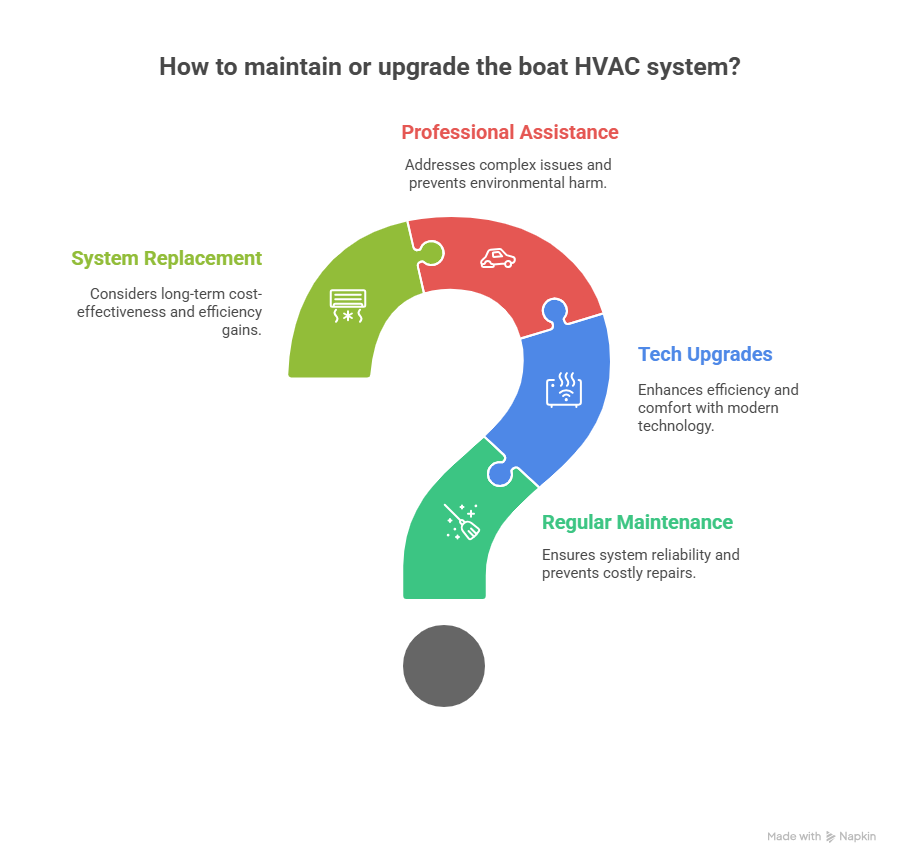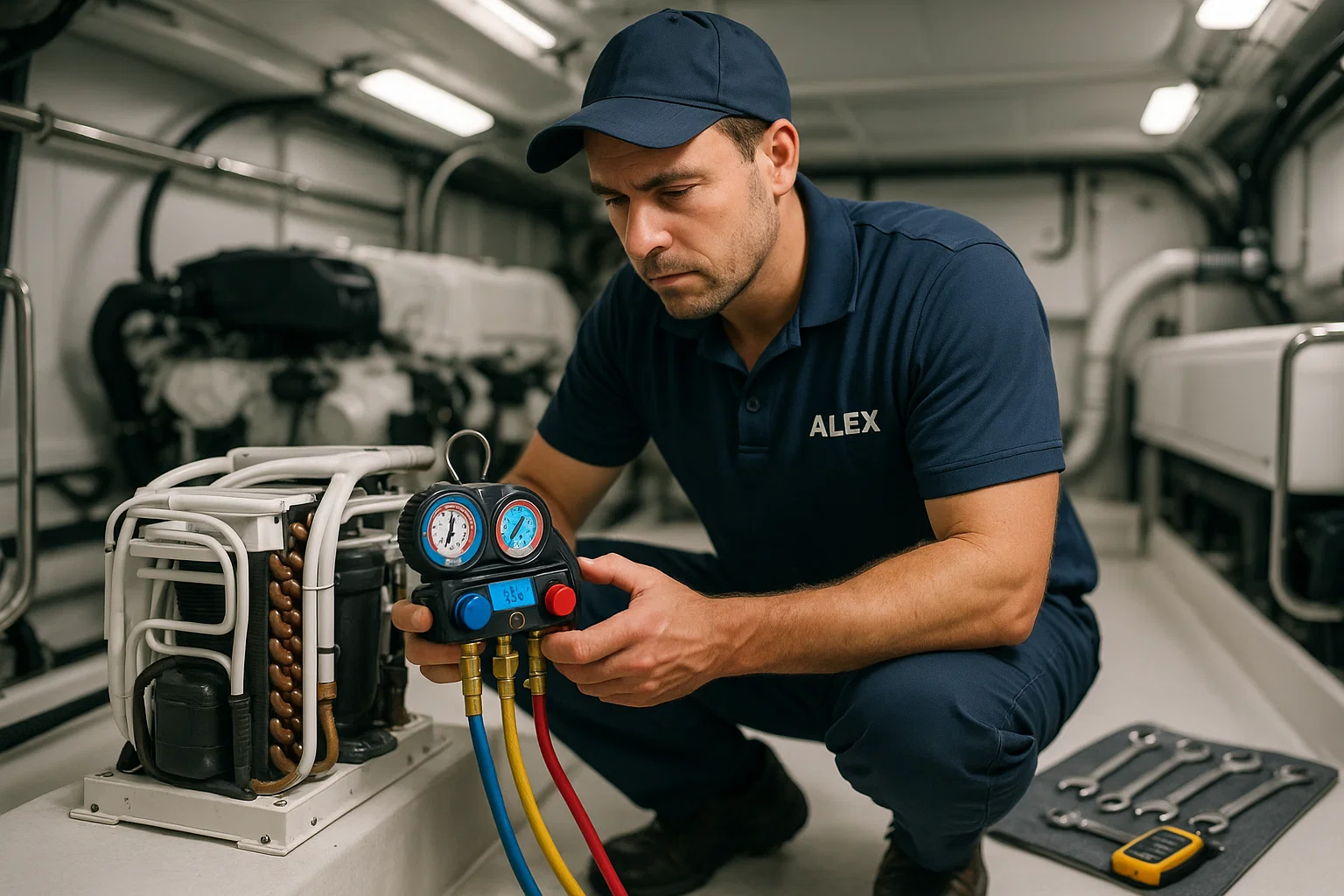The Day a Sea Ray Turned into a Swamp Cooler
I’ll never forget it. Middle of August, so hot you could fry an egg on the dock at Bahia Mar. A client, Javier, calls me in a panic. His family is miserable on their new-to-them Sea Ray 400. “Alex,” he says, “it’s like a swamp in here. The A/C is running, but it’s just blowing wet, lukewarm air.”
I get down there, and sure enough, it’s an absolute sauna. The problem? A sea strainer so clogged with seaweed and barnacles it looked like a science experiment. His boat HVAC system was basically suffocating. We spent an hour cleaning it out, flushed the lines, and within minutes, crisp, cold air was pumping through the vents. Javier looked at me like I’d just performed magic.
That’s the thing about a boat HVAC system. It’s not just a luxury; it’s the workhorse that makes life on the water bearable, especially here in South Florida. It keeps you comfortable, fights off that nasty mildew smell, and protects your boat’s interior. But most people ignore it until it quits on the hottest day of the year.
So, let’s talk about how to keep your system from turning into a swamp cooler. I’ll walk you through the basics, some maintenance tricks I’ve learned over the years, and when it’s time to call in a pro.
Table of Contents
Understanding Your Boat HVAC System (The Simple Version)
You don’t need an engineering degree to get the gist of your boat HVAC system. Think of it as a simple loop.
- The compressor is the heart, pumping refrigerant (what most people call Freon) around.
- The condenser uses seawater to pull heat out of that refrigerant. This is where that clogged sea strainer caused Javier’s problem.
- The evaporator is inside the cabin. As cold refrigerant flows through it, a fan blows air across it, and voilà—cold air for you.
- Air handlers are just the boxes with the fans, and ductwork carries that cool air around your boat.
It’s a straightforward setup, but if one part gets gummed up or fails, the whole chain breaks down. Keeping each part happy is the key to a reliable boat HVAC system.
My Non-Negotiable Maintenance Checklist
If you do nothing else, do this stuff. Regular maintenance is what separates a reliable boat HVAC system from one that’s a ticking time bomb. It’s what I tell every single one of my clients.
The Power of Just Looking and Listening
Seriously, your eyes and ears are your best first defense. Once a month, just poke around. Listen for new rattles or groans from the compressor. Sniff the air coming out of the vents—does it smell musty? A little bit of proactive snooping can save you a thousand-dollar repair bill. I caught a loose wire on a boat in Coconut Grove just because the owner mentioned a “weird new humming sound.”
Keeping It Clean for Peak Performance
A clean system is a happy system. Here’s a simple schedule I put together. It’s what I follow for my own boat.
| Task | How Often? | Mechanic’s Tip from Me |
|---|---|---|
| Clean/Replace Air Filters | Every 1-3 Months | Don’t just bang it on the dock. Use a shop vac or rinse it properly. A clogged filter makes your whole system work harder. |
| Inspect/Clean Sea Strainer | Monthly | This is #1 for a reason. In Florida, I check mine weekly. You won’t believe the junk that gets sucked in there. |
| Acid-Flush Condenser Coils | Annually (Pro Job) | Don’t try this yourself unless you know what you’re doing. Scale buildup inside the coils kills efficiency. |
| Check Condensate Drain Pan | Every Few Months | Make sure it’s draining freely. A clogged drain leads to standing water, which is a mold party waiting to happen. |
| Vacuum Air Ducts | Annually | You’d be amazed at the dust and grime that builds up. Better air quality and better airflow. |
Keeping a small logbook of when you did what is a great idea. It helps you spot trends and remember what you did last season.
Tech Upgrades That Actually Make a Difference
The tech in a modern boat HVAC system has gotten pretty slick. It’s not just about getting cold anymore; it’s about being smart.
Variable Speed: The End of “On-Off-On-Off”
Older systems are like a light switch: full blast on, or completely off. This is why you wake up freezing, turn it off, and then wake up sweating an hour later. The new variable speed systems are like cruise control. They ramp up or down to precisely match what the cabin needs. They are quieter, use way less energy, and you don’t get those annoying temperature swings. A client with a Viking switched over, and he said his generator run-time was cut nearly in half.
Smart Controls
You can now get thermostats that you can control from your phone or even your chartplotter. It’s nice to be able to cool the boat down on your way back to the marina. Some of these systems will even send you an alert if something is wrong, like if the compressor is vibrating too much or the refrigerant pressure is off. It’s like having a digital mechanic on board.

Knowing When to Call for Backup
You can and should handle the basic maintenance. But there are times when you need to put the tools down and call a pro.
If you suspect a refrigerant leak (your system just isn’t getting cold like it used to), that’s a job for a certified tech. We have the gauges, vacuum pumps, and leak detectors to do it right. Messing with refrigerant without the right gear is bad for the system and bad for the environment. The same goes for any major electrical issue or if the compressor dies. A good technician can diagnose a tricky problem with a complex boat HVAC system in a fraction of the time it would take a DIYer.
The Big Question: Repair or Replace?
If your boat HVAC system is over 10-15 years old and you’re facing a big repair bill (like a new compressor, which can be $1,000+), you need to think hard. Sometimes, putting that money toward a new, more efficient unit is the smarter long-term play. A modern system can be 20-30% more efficient, which saves you fuel and wear-and-tear on your generator.
So, What’s the Bottom Line?
Look, if you want to keep your boat HVAC system humming and avoid those sweaty, miserable days on the water, this is the stuff that really matters. The advice I give all my clients:
- Maintenance Isn’t Optional: Your HVAC needs love. Clean those filters and sea strainers regularly. It’s the cheapest insurance you can buy against a big repair bill.
- Embrace the New Tech (When it Makes Sense): Variable speed systems are a game-changer for comfort and efficiency. If you’re replacing an old unit, it’s worth the upgrade.
- Listen to Your System: Weird noises and musty smells are your boat’s way of telling you something is wrong. Don’t ignore them.
- Protect the Core Parts: A happy boat HVAC system has the right amount of refrigerant, a clean seawater circuit, and solid electrical connections.
- Know Your Limits: Handle the basics, but for big, complicated problems with your boat HVAC system, call a pro. It will save you time, money, and a lot of frustration in the long run.
Your boat’s climate control is what stands between you and a miserable day. Treat it right, and it will treat you right for years to come.
Author Bio
I’m Alex, a 15-year marine technician in South Florida, ABYC-certified. I’ve troubleshooted and installed hundreds of marine air conditioning units, from small self-contained systems to complex chillers on sportfishers and yachts. At marinas like Dinner Key and Bahia Mar, I’m the guy they call when the A/C quits on the hottest day of the year.


Leave a Reply